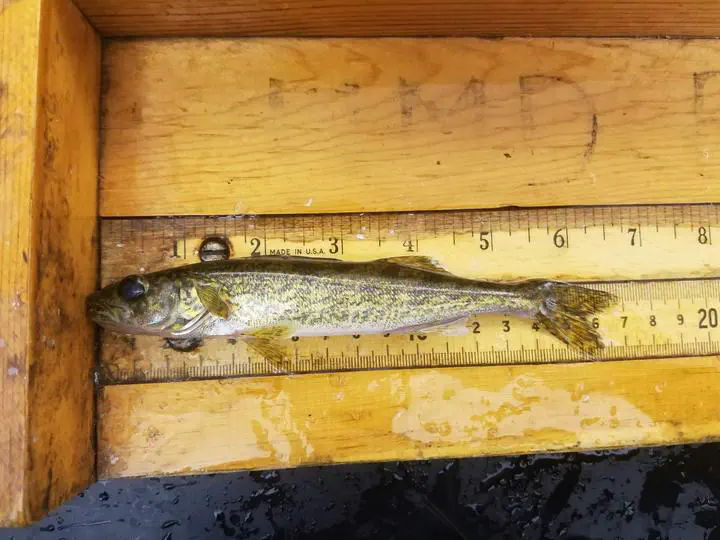Environmental drivers of fish assemblages

The abiotic and biotic drivers of the environments fish experience in lakes can have strong filtering effects on the species that can live there and the population dynamics of those species. Using continental-, regional-, and lake-scale data on environmental conditions, we aim to develop new habitat management tools to promote fisheries outcomes in north-temperate systems.
Our work in this area is multi-faceted, covering everything from the abiotic and biotic drivers of fish recruitment and recruitment synchrony across landscapes, to interactions between aquatic plant communities and fish communities. Aquatic plants are an often underappreciated aspect of habitat for many fish species. For example, we lack a strong understanding of how plants and fish interact, and how different plant communities may structure fish assemblages or population dynamics. Layered over structural habitat, in-lake environments controlled by depth, productivity, or clarity also determine whether and how well a species may thrive in a particular place. Population demography has also proven to be an important component of understanding changes in fish recruitment in the Upper Mideest. We collaborate widely with state agencies, tribes, and the Midwest Glacial Lakes Partnership to build data and models to answer questions about fish-habitat relationships, with the goal of creating additional tools to put in the lake management toolbox that can improve fisheries outcomes, strengthen resilience to climate change, and ensure lakes continue to provide critical ecosystem services.
Photo: A young-of-year walleye. Credit: Greg Sass, WDNR.
Relevant publications
Dassow, C., G.G. Sass, S.L. Shaw, Z.S. Feiner, C. Niemann, and S. Jones. 2023. Depensation in fish recruitment driven by context-dependent interactions with another predator. Fisheries Research 262: 106675.
Krabbenhoft, C.A., S.S. Ludsin, E.A. Marschall, R.R. Budnik, L.Z. Almeida, C.L. Cahill, H.S. Embke, Z.S. Feiner, P.J. Schmalz, M.J. Thorstensen, M.J. Weber, M.R. Wuellner, and G.J.A. Hansen. 2023. Synthesizing professional opinion and published science to build a conceptual model of walleye recruitment. Fisheries 48: 141-156. doi: 10.1002/fsh.10884.
Broda, S., J.T. Mrnak, Z.S Feiner, S.L. Shaw, and G.G. Sass. 2022. Black crappie influences on walleye natural recruitment in northern Wisconsin lakes. North American Journal of Fisheries Management 42: 1202-1214.
Embke, H., S. Carpenter, D. Isermann, G. Coppola, D. Beard, A. Lynch, G. Sass, Z.S. Feiner, M.J. Vander Zanden. 2022. Resisting ecosystem transformation through an intensive whole-lake fish removal experiment. Fisheries Management and Ecology 29: 364-377.
Foley, C.J., and Z.S. Feiner. 2021. Spatial patterns in dry weight of six Lake Michigan prey fishes. Journal of Great Lakes Research 47: 1836-1843.
Sass, G.G., Z.S. Feiner, and S.L. Shaw. 2021. Empirical evidence for depensation in freshwater fisheries. Fisheries 46: 266-276.
Honsey, A.E., Z.S. Feiner, and G.J.A. Hansen. 2020. Drivers of walleye recruitment in Minnesota’s large lakes. Canadian Journal of Fisheries and Aquatic Sciences 77: 1921-1933.
Feiner, Z.S., D.P. Coulter, D.P., and T.O. Höök. 2019. A question of scale: Weak evidence for broad regional synchrony in fish recruitment within or among species in inland lakes. Fisheries Research 214: 45-55.
Feiner, Z.S., D.P. Coulter, T. Krieg, S.B. Donabauer, and T.O. Höök. 2016. Environmental influences on fish assemblage variation among ecologically similar glacial lakes. Environmental Biology of Fishes 99: 829-843.
Sullivan, C., D.P. Coulter, Z.S. Feiner, S. Donabauer, and T.O. Höök. 2015. Influences of gear type and analytical methodology on fish assemblage characterisations in temperate lakes. Fisheries Management and Ecology 22: 388-399.